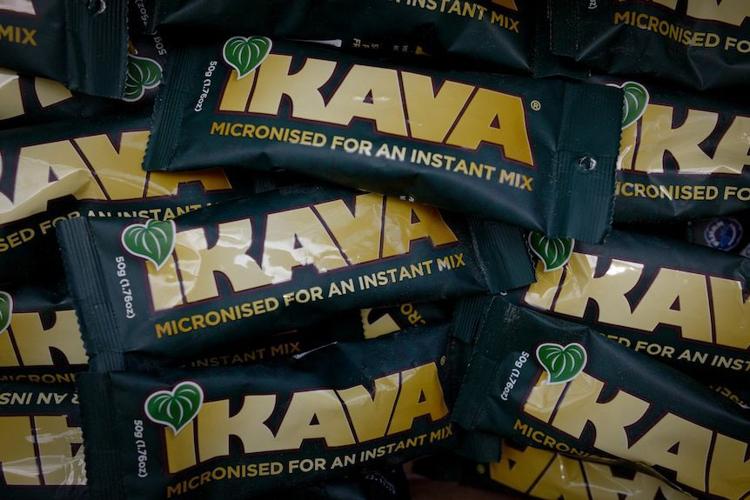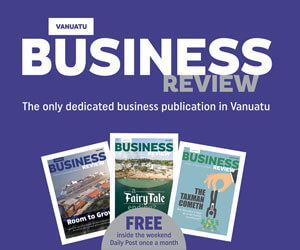Would you go to a kava bar? Producers of the psychoactive drink want a mainstream market
February 15, 2022 2:09 am | Posted in Business News | Share now TwitterFacebook
By Emily Clark, Lice Movono and Fletcher Yeung in Suva.

You can’t just take a sip of kava; you have to drink the whole bowl down in one go and you can’t have it when you’re angry or it’ll make you feel worse. That’s the advice in Fiji.
There is a traditional way to consume the drink known for its relaxation effects, but there are also kava bars and cafes and sachets of instant mix.
In modern times, the drink made from the root of the yoqona plant hasn’t had a great reputation, condemned as something that numbs the brain and ‘dopes’ the drinker.
But in Fiji, it’s attracting a new crowd — the after-work corporate crew who want to unwind, and the Saturday night social scene that has found a way to hang out and listen to music without consuming alcohol.
Kava is a controlled substance in Australia, but some of the regulations around it are changing and producers across the Pacific are hoping their product can find a new market in the mainstream.
‘It feels good’
Mana Coffee in Suva has a children’s playpen out front and and all-day breakfast menu. Come evening, the back room turns into a kava bar and on this Saturday night, it’s full.
The band in the corner is taking breaks only to down a bowl of kava, with one member insisting the drink “makes you happy”.
“It’s stress relief. If you’ve had a long day, one bowl is relaxing. It feels good,” he said.
As the hours pass, a few tables change, but mostly those who are here are in for the night. Each group of friends shares a communal bowl — the tanoa — and slowly empties it, snacking on salty ‘chasers’ between drinks.
Suluetiwainiqolo Vukialau first had kava when she was 18. And while she didn’t like the taste initially, the drink has come to play a very special role in her life.
“Sometimes I have kava with my dad or uncles. Some of them come from work, stressed, I will sit with them, we communicate and enjoy each other’s company,” she said.
“It’s been a long day, and we’ve been separated, and then we come together as a family in front of the tanoa and we share kava together.
“It means a lot.”
It’s easy to buy kava across Suva. Convenience stores sell high-grade powder next to the day’s newspapers, fresh eggs and spare batteries, and as you drive through the city there are countless dive bars serving the drink.
But Mana Coffee has found a new market and it’s this consumer that kava producers in Fiji are hoping they will be able to find in Australia.
From their village to your cafe
To enter some remote villages in Fiji, you have to seek permission from the chief and part of that is making an offering of kava.
A ceremony takes place and after downing a bowl of the drink, you’re welcomed and are allowed to move around.
The village of Navunisole is about an hour outside of Suva along the ring road that circles the main Fijian island of Viti Levu.
It’s a small community with big plans for their kava crop.
Farmer Aleveo Basaga believes selling his kava to overseas markets will lift the standard of living for everyone in Navunisole.
“In Australia, America, if they like kava, it’s good for them and for us too,” he said.
The men gathered around to show off the kava crop are speaking Fijian. It’s explained that they’re saying how lucky they are to have their farm visited and Aleveo is nervous to be interviewed.
He’s surrounded by children of the village and gestures to them when he’s talking about his vision.
“Harvesting my kava, I sell it, I get the profit… share it in the village so we can all grow up together,” Aleveo said.
Kava is one of the most valuable crops across the Pacific.
Aleveo and his workers dig up a three-year-old plant to reveal its root system — the fibrous threads that will be processed into powder and, hopefully, exported across the world.
He says this yield is worth $FJD400 ($263).
Across Fiji, there are more than 10,000 kava growers whose households and communities will benefit from growth of the industry.
But for the potential economic impacts to be realised, Fiji’s kava needs to evolve from its raw form to standardised and safe consumer products.
In 2019, the Australian government announced it would allow the commercial imports of kava from Pacific Island nations — something that was banned 15 years ago.
Kava was introduced into Australian Indigenous communities in the 1980s as a substitute for alcohol, but excessive consumption in some areas led to health problems.
Kava was listed as a schedule 4 drug and prohibited from being brought into the country in commercial quantities.
The Australian Drug Foundation warns the consumption of kava can lead to liver damage when consumed with alcohol.
The government’s own risk statement notes: “ongoing high-quantity consumption has been associated with ichthyosiform skin rash, altered liver function and a decline in general health.”
The decision from Scott Morrison’s government to lift its ban on kava imports was an unexpected one and Indigenous leaders warned it would put their communities at risk.
Now, the date set down as the moment commercial imports could resume has arrived.
From December 1, importers have been able to apply for a permit to bring kava into Australia and ultimately sell it to consumers.
For Fijian producers, the challenge now is to ensure their products meet all the regulatory requirements and that they can connect with an importer in Australia.
An Australian and New Zealand government-backed program called PHAMA Plus helps industries in the Pacific gain access to foreign markets.
Sangita Kumar from PHAMA Plus has been working with Fiji’s kava industry.
“There is a disconnect that happens between producers, the exporters and the market, so we are trying to bridge that gap,” she said.
“Given the opening of the commercial kava pilot in the Australian market, it becomes even more important to make farmers aware of what the market requirements are.
“It’s an opportunity for our exporters to enter into a new market segment in Australia, beyond the Pacific diaspora.”
At the end of last year, there had been 133 applications for permits to import kava during the trial.
Kava next to tea and coffee
From raw kava root, to a standardised powdered product with regulation labelling — that’s the process the Fiji industry has been trying to nail.
The chemicals in kava that give the drinker feelings of relaxation and a sensation that has been compared to prescription medications such as Valium or Tempazepam are called kavalactones.
This active ingredient varies depending on where the kava was grown and how it’s been processed, so to sell kava in Australia, processors in Fiji needed to standardise their formula.
Lami Kava director Donny Yee Jason has made changes to the company’s processing facilities to meet regulations.
“We control the environment, we control the cleaning, we control the drying and the peeling, so the whole process has been controlled,” he said.
Individuals are allowed to bring kava powder into Australia for personal use, but the quantity is capped at 4 kilograms per person and it’s usually in unlabelled packaging.
An amendment to Australia’s prohibited imports legislation has cleared the way for kava to arrive in commercial quantities, provided the importer obtains a licence and meets other relevant regulations.
The products will still be subject to state and territory legislation and currently the sale of kava is prohibited in the Northern Territory.
The types of stores it can be sold in and and who is allowed to buy it will also be subject to state and territory regulations, as well as national food standards, which are currently being updated.
Existing permissions around kava in the food standard seek to limit its consumption to traditional use.
But submitted as part of the review process, a Food Standards of Australia and New Zealand proposal noted:
“In recent times, [kava] has become more widely consumed as a recreational beverage in both the Pacific community as well as in the wider international community.
“This significant history of use demonstrates that it is possible to safely consume kava beverage in moderation for traditional and recreational purposes.”
For members of the Pacific Island diaspora, easily accessing kava in Australia is about easily connecting to culture.
Donny wants kava to have a broader appeal too, and for Australians to think about the drink like they do some of their favourites.
“We want to place it alongside tea and coffee — cafes, supermarkets, health shops,” he said.
“America was the same. It started off with the Pacific Islander diaspora, and then it’s grown into the typical American drinking it now.
“There are over 300 kava bars in America, so hopefully the same thing will happen in Australia. Only time will tell.”
– ABC










